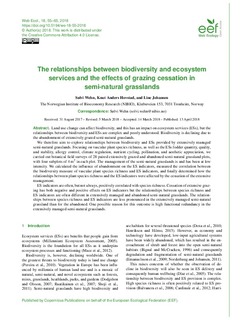| dc.description.abstract | Land use change can affect biodiversity, and this has an impact on ecosystem services (ESs), but the relationships between biodiversity and ESs are complex and poorly understood. Biodiversity is declining due to the abandonment of extensively grazed semi-natural grasslands. We therefore aim to explore relationships between biodiversity and ESs provided by extensively managed semi-natural grasslands. Focusing on vascular plant species richness, as well as the ESs fodder quantity, quality, and stability, allergy control, climate regulation, nutrient cycling, pollination, and aesthetic appreciation, we carried out botanical field surveys of 28 paired extensively grazed and abandoned semi-natural grassland plots, with four subplots of 4m2 in each plot. The management of the semi-natural grasslands is and has been at low intensity. We calculated the influence of abandonment on the ES indicators, measured the correlation between the biodiversity measure of vascular plant species richness and ES indicators, and finally determined how the relationships between plant species richness and the ES indicators were affected by the cessation of the extensive management. ES indicators are often, but not always, positively correlated with species richness. Cessation of extensive grazing has both negative and positive effects on ES indicators but the relationships between species richness and ES indicators are often different in extensively managed and abandoned semi-natural grasslands. The relationships between species richness and ES indicators are less pronounced in the extensively managed semi-natural grassland than for the abandoned. One possible reason for this outcome is high functional redundancy in the extensively managed semi-natural grasslands. | nb_NO |

